In the first part of this series, I covered the rise of technology in the music industry and how it shaped the music creation and listening habits of the day. In the late 1990s, the music industry was facing its biggest challenge due to the invention of the mp3, internet, and the peer to peer networks. In this part, I will take you through this journey of piracy, the ushering-in of streaming, and the impact of social media and TikTok on our music listening.
One of the biggest issues with the rise of the Internet was the ease-of-accessibility to pirated content. From music to video games, various industries were affected by piracy and thus created countermeasures to protect their content. As a result, the music industry became incredibly strict in enforcing copyright laws.
Starting with the introduction of digital, as opposed to analog formats in the 1980s, technological advances began to break down the previously rigid infrastructure of the recording industry. This burst of change effectively eliminated many of the barriers within production, distribution, and promotion. The production costs of music began to fall drastically starting in the 1990s when new technologies made robust recording equipment available to individual musicians.
Piracy was a relatively harmless issue with analog phonograph records as the quality was reduced with every additional copy made. Digital formats could be replicated infinite times without losing fidelity making copies perfect substitutes for the original. Mp3, which shrank the size of a regular CD to around 11% of the original, made it viable to transfer it quickly between devices. Soon, the Internet was invented and made readily available to individuals at home, which enabled them to widely distribute and download digital copies making piracy the new normal way of acquiring and listening to music.
The backbone of this was the peer-to-peer(P2P) networks. In a peer-to-peer network, each computer acts as both a server and a client — supplying and receiving files — with bandwidth and processing distributed among all members of the network. P2P file-sharing was introduced to the general public in 1999 when American college student Shawn Fanning created the music-sharing service Napster. It employed a centralized index server, which users would search on the basis of a song title or artist name. If the index located the song on the hard drive of any other computer that was currently connected to the network, a user could download a personal copy while simultaneously offering his or her own computer-supplied files in response to other users’ searches.
In its first sixteen months, Napster boasted an impressive user base of 80 million. The Recording Industry Association of America(RIAA), representing the major record labels, filed suit in San Francisco federal court for contributory copyright infringement in what would be a drawn-out, and highly publicized, legal drama. Napster was ordered to shut down and filed for bankruptcy in June of 2002.
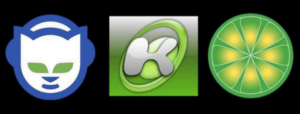
Napster, Kazaa, Limewire(Company logos)
Although the RIAA was successfully able to shut down Napster, they now faced countless other sites that utilized this new technology. While the original P2P applications, hosted file names on their own server, more advanced programs, starting with Gnutella, actually created a dispersed network directly connecting computers consequently removing the need for a centralized directory. The diluted nature of the system also made it difficult to fully shut down. In 2003, the RIAA began filing suit against individuals, who had used the P2P program, Kazaa, to illegally share large numbers of files. This deterred the users from using Kazaa but multiple others like Limewire and BitTorrent showed up around the same time and it became increasingly difficult to tame them. The efforts of the RIAA were certainly effective in combating music piracy, but it was simply impossible to eliminate its presence as the technology continued to improve.
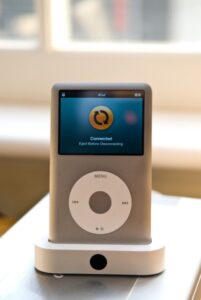
Apple iPod
The big change from the industry’s side came in the form of Apple’s iTunes store in April 2003. It allowed Mac users to purchase songs for 99¢ each and albums for $9.99 without any subscription fee. For the first time, the albums were de-bundled and sold as independent songs. Within its first week alone, the iTunes store sold over a million songs from its then extensive library size of 200,000 tracks. Perhaps the most important expansion, though, occurred in October 2003 when the Apple Music Store, and iTunes application, was made available to PC users. By December 2003, less than a year from its launch, the iTunes store had sold 20 million songs. The most vital reason, though, was that digital sales of music for Apple were tied to another extremely profitable and widely successful product in their MP3 player, the iPod (and subsequently the iPhone). This integrated, and easy-to-use, interface across Mac computers, iPods and iPhones and digital music positioned Apple perfectly to foster the entrance of a new chapter for the music industry.
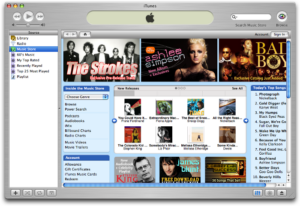
Apple iTunes store — 2003 (Image credits — Guidebook Gallery)
Apple’s success served as motivation for other established companies, such as Amazon and Google, to begin selling music digitally. Further, it forced innovation among small companies seeking to create a viable business model around digital music and a few have been able to thrive. The Swedish company, Spotify, created a subscription-based model with a desktop application similar to iTunes, and a library that matched their size. Digital sales of music surpassed physical sales for the first time in 2011 and have been the case till now.
Today, there are multiple options for digital music streaming like Spotify, Apple Music, Deezer, Youtube Music, and many others. One thing all these music streaming platforms have in common is their algorithmic framework that leverages machine learning to combat the music preferences and listening behaviour of their audience. With all of this combined with the platforms optimizing UX, we are in a new era of world music discovery. Major music streaming platforms are doing a great job of giving their listener base what they want in the form of customized and branded playlists. Prior to the streaming era, music discovery predicated on mass media (i.e. radio and MTV) and word-of-mouth recommendations.
One obvious effect of playlist-driven listening is the declining focus on albums(feel bad for concept albums!) and increasing focus on individual songs. A study by LOOP in the US found that playlists account for 31% of the listening time across all demographics, compared to albums which account for 22%. Another side effect of the streaming era is the shortening of the duration of songs. The average UK number one in 1998 was four minutes and 16 seconds long, while 2019’s average was just three minutes and three seconds. With attention spans waning, shorter songs have taken priority to increase the chances that a play of an artist’s song will help them accumulate equivalent sales quicker. However, there has been an increase in the number of songs per album presumably in the hope that the algorithms pick up at least one song and place it into popular playlists. These playlists also increase artists’ chances of getting larger streaming numbers, thus improving their chart positions.
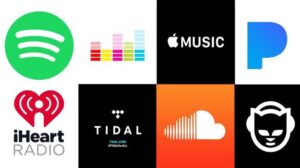
Major digital streaming platforms
Spotify, Apple Music, and their rapid growth indicate a shift in consumer expectation for music whenever and wherever. Platforms like YouTube Music, Soundcloud, Pandora, and Tidal are also heavily used and you could argue that streaming platforms have become so ubiquitous they can now be broken down by use-case — e.g. extensive catalog, independent artist discovery, passive listening, or better audio quality. Independent artists are now putting their fate in their own hands, bypassing labels, uploading their projects to online streaming platforms, and speaking to their fans directly through their social media. Websites like Landr allow artists to master their own tracks (significantly increasing the sound quality), platforms like Bandcamp give artists the space to sell their music for either pre-set or donated prices, and websites like Patreon have given fans the ability to pledge a monthly fee to their favorite indie artists.
The erosion of personal stakes and agency in music consumption has made music less a part of our personal identities and more of a digital commodity, for better and for worse. The commodification of music is a direct result of democratized access to recorded music led by the streaming model, which, in turn, shifted the point of monetization to accessing live music. Touring has become the main revenue stream for the music industry, for concerts and music festivals provide an in-person experience that has yet to be commodified by digital distribution.
Facebook, Instagram, Twitter, and other social networks enable an increased level of interaction between music artists and their followers. The ability to share songs, albums, and playlists on social media platforms has given people new ways to show their followers what they’re listening to. A study conducted by MusicWatch shows that 90% of social media users take part in some form of music or artist-related activity on social platforms. Two-thirds of social media users agree that they discover new artists on social media, and nearly 60% are visiting online streaming services/platforms to listen to music after they see an update, tweet, or post.
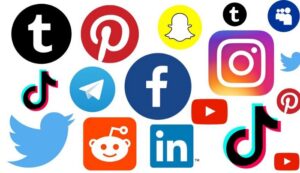
Major social media platforms impacting music
According to the TikTok “Year on TikTok” report, there were 176 songs that were featured in 1 billion unique video views on the app in 2020 alone. With TikTok, songs are broken down into short clips of drops and hooks, designed to convey a certain mood and provide audio cues for visuals, and their popularity is defined by the number of users who have created their TikToks using the same audio. The rise of streaming transferred the hit-making power from mass media to algorithms; now TikTok is ushering in a new era where listeners get to directly participate in the creation of hit songs. In response, record labels are moving quickly to sign artists with breakout tracks on TikTok, betting that their popularity will transfer to other platforms.
Following the co-creative trend championed by TikTok, music is becoming a part of digital creative toolkits for everyone to play with. For instance, everyone can now easily add any song available for streaming as the background music for their Instagram or Snapchat stories. As the attention economy peaks, music not only has to compete with other forms of media for attention, it is also converging with other creative formats.
We at Beatoven.ai are making an AI music composer which can understand the context of your video or podcast and score the background music and sound effects for it. Do check us out and get in touch by filling in your details on our website.

